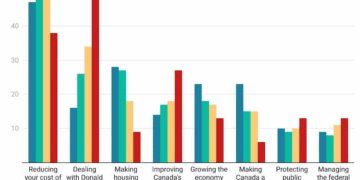In July 2023, Mark Green – the Republican Chair of the House Homeland Security Committee – made a shocking announcement. The former U.S. Army Major, who now represents the state of Tennessee in Congress, claimed that it was “very likely” that China was managing to insert “military personnel” into the United States. How? By sneaking them through the border between Mexico and the U.S. Green claims there has been a “massive surge” of Chinese nationals being encountered at the border, and that many of those nationals are military-aged men with known ties to the People’s Liberation Army, or PLA, and even China’s ruling communist party. That’s worrying stuff for intelligence officials in the United States. But are Green’s claims all that they’re cracked up to be? Or, are there reasons beyond the militaristic one for why we’re seeing such a large influx of Chinese nationals trying to make their way into the U.S. via Mexico? This video explores the answers to that question. And we start by digging deeper into Green’s claims. Green’s comments came during the same announcement in which he told the media that he – along with some of his Congressional colleagues – would be launching an investigation into Alejandro Mayorkas. Currently serving as the Secretary of Homeland Security, Mayorkas is overseeing what some are calling a “border crisis,” accentuated by the recent death of a migrant child who had been taken into U.S. custody. It appears Green’s approach is simple. Not only may he criticize Mayorkas for that unexpected death, but he’ll use the opportunity to bring up the possibility that his oversight of the border between Mexico and the U.S. is so subpar that he’s allowing national security threats into the country. He could even point to comments from Melissa Dalton – the Assistant Secretary of Defense for Homeland Defense – as his evidence. In March 2023, she claimed that China – in addition to Russia – was now finding ways to pose “more dangerous challenges to the safety and security of the U.S. homeland.” Sending operatives into the U.S. via the Mexican border could be one of those ways. Green also has data to back up his claims. According to Newsweek, which pulled data from the U.S. Customs and Border Protection, or CBP, agency, 2023 saw an alarming spike in confrontations with Chinese nationals at the border. Between October 2022 and April 2023, the CBP reports 9,854 encounters with Chinese nationals. The figure for the entire fiscal year prior – running from October 2022 to September 2023 – was just 2,176. That certainly seems like a sudden influx. And the news could be even more worrying to the security-conscious when you consider the makeup of the 9,854 encounters. Newsweek reports that only 1,500 of those encounters included individuals who were crossing as part of a family unit. The other 8,304 were all single adults. We don’t know much about those adults. Were they men or women? What were their ages? None of that information is publicly available, nor has the U.S. government made any claims that these individuals had any defined ties to Beijing. Still, that vagueness in itself is a worry. Green also has backing from some independent sources. Those include Dr. Rebecca Grant, who serves as an analyst at IRIS Independent Research. She spoke to Newsweek about the issue, claiming that she personally believes Green’s claims that China is sneaking operatives into the U.S. via Mexico to be true – at least, in part – pointing out that there were 5.4 million Chinese nationals in the U.S. as of 2021. Grant says it’s not a huge stretch to believe at least some of those people have ties to Beijing. And, as she puts it, “If you’re a bad guy that wants to infiltrate operatives into the U.S.A., the southern border is a pretty easy way to do it.” However, Green is less than forthcoming when quizzed about the sources behind his claims. All he’s said is that he got the information from a border sector chief, adding that he’ll be taking part in a classified briefing on the issue “in the very near future.” Grant says that briefing is really a case of no smoke without fire. She points out that not having any additional information isn’t unlikely, given that the intelligence community isn’t going to provide public figures in terms of how many potential Chinese infiltrators it has caught. But the mere fact that Congress is going to be briefed on the situation suggests that something is going on. We can also dig deeper into the numbers to see the sheer scale of the Chinese influx. According to CBS News, 2023 saw the U.S. CBP record a staggering 2.5 million instances of turning away or detaining people attempting to cross the border between the U.S. and Mexico. That’s a record-breaking number, suggesting that more people than ever are trying to make the journey. But, in line with Green’s claims, Chinese migrants represent the fastest-growing group among that 2.5 million. Interestingly, not all of those Chinese migrants are trying to make the crossing via official channels. CBS even recorded footage of several large groups – many seeming to be from middle-class family backgrounds – managing to sneak through a four-foot gap at one end of a border fence that sits just 60 miles east of San Diego. All they had to do was duck under some razor wire and they were inside the country. CBS also offers more numbers related to how many Chinese citizens were apprehended trying to cross the border illegally. Startlingly, they’re even higher than the numbers that Newsweek reports. CBS says that the U.S. CBP reported the apprehension of around 37,000 Chinese citizens attempting to cross into the U.S. in 2023 – a number that’s 50 times more than that recorded in 2021. Of course, the caveat here is that 2021 also saw restrictions on Chinese movement at an all-time high as a result of the pandemic, so it’s no surprise that 2023 brought with it much higher numbers. You could even argue that many of the 37,000 are Chinese citizens who would have attempted the crossing earlier, were they not stuck in China due to pandemic restrictions. Still, it’s more fuel for Green’s fire. Not only can he point to suspicions that he and others in the independent media and intelligence community have about China sneaking operatives into the U.S. He can also highlight the record-breaking numbers of Chinese citizens trying to make the crossing. Naturally, not all of those citizens will be involved in subterfuge. Some merely want to escape China to build a better life for themselves, which we’ll dig deeper into later in the video. But, as Green and Grant suggest, it’s highly likely that at least a small portion of the 37,000 who were detained in 2023 would have had a nefarious purpose for making the crossing. Even more numbers come from AP News. It claims that 22,187 arrests of Chinese citizens were made at the U.S.-Mexico border between January and September 2023, which roughly tracks with the 36,000 number that CBS shared. It also points out that this is 13 times the number of arrests made in 2022, with September 2023 alone recording 4,010 arrests. That’s 70% more than the number of arrests recorded in the previous month, suggesting that Chinese citizens started attempting the border crossing in higher numbers toward the end of 2023. By the end of September 2023, Chinese people became the ninth-highest nationality – in terms of pure volume – being arrested at the border, and led the way for nationals from countries outside of Mexico, Central America, and South America. And, as Newsweek also points out, the majority of those arrested were single adults. By now, it’s clear: More Chinese nationals are trying to enter the United States than ever before. But does that really lend credence to Green’s claims that the U.S. faces a national security threat from this increasing number of attempted border crossings? Or, are there other reasons at play that may account for the rising numbers the U.S. CBP is reporting? To answer that question, we first need to provide context on the sheer amount of danger a Chinese citizen faces when attempting this border crossing. It isn’t a simple task, as highlighted by a short interview held by CBS reporter Sharyn Alfonsi with a Chinese college graduate who claims that it took him 40 days to travel from China to Los Angeles. Alfonsi asked the student what countries he had to travel through to make the journal, and received a laundry list of nations in response. Before the student even made it to South America, he had to travel through both Thailand and Morocco. From Morocco, he reached Ecuador, traveling from there through Colombia, Panama, Nicaragua, and Costa Rica before he finally reached Mexico. And even after all of that traveling, he still had to make his way through Mexico itself, all to finally reach the four-foot hole in the border fence mentioned earlier to finally get into the United States. Alfonsi only had one word in reply to that journey: “Jeez.” However, that journey isn’t typical for all Chinese nationals attempting to make the crossing. Alfonsi also highlights that many – especially middle-class migrants – tend to fly from China into Ecuador first. That’s easy for them to do. Ecuador doesn’t require Chinese nationals to apply for a visa to enter the country, with a 90-day tourist visa automatically offered to anybody who makes the trip. All the traveler has to do is ensure they have a Chinese passport – valid for at least six months – as well as documentation showing how they intend to depart from Ecuador. For many middle-class Chinese migrants, that documentation comes in the form of plane tickets to Mexico. Specifically, they head to Tijuana, according to Alfonsi, where they link up with “snakeheads.” These Chinese gangs work alongside Mexican cartels to then smuggle Chinese citizens into the U.S. You could argue that this represents a less perilous journey than the college student’s crossing, during which he traveled through around half a dozen countries. But it’s still dangerous to associate with gangs to try and get into America. Plus, there’s the cost – the snakeheads charge $400 for a one-hour drive to the four-foot gap. Add the air travel from China, and then from Ecuador, into the mix, along with paying for the connections to the smugglers in the first place, and the trip can cost upwards of $14,000 all told. Either way, the journey into the United States isn’t easy. It either involves traveling through multiple countries – taking around 40 days – or working alongside smugglers and spending huge amounts of money to sneak inside. All of which brings us back to a question: Why are so many Chinese nationals taking these risks and spending this money? Green has already made his case, at least for a few of those nationals. They’re not migrating – illegally or otherwise – into the United States to find a better life. At least, not all of them. A select few are entering the country to spy on Beijing’s behalf, perhaps with the goal of delivering valuable intel about the American military to the Chinese Communist Party, or CCP. This would be far from the first case of China trying to find ways to get information about the United States. Green points to the infamous “Chinese spy balloon” incident of February 2023, in which a balloon of Chinese origin spent several days flying over the continental United States. Eventually, that balloon was shot down by an F-22 fighter jet and would have been shot down sooner if it hadn’t been above land. China claimed the balloon was simply a weather-tracking device that had gone astray. But many in the U.S. were up in arms about the possibilities, even in the wake of the revelation that the balloon actually wasn’t collecting any intelligence. That was confirmed by CBS News Sunday Morning in an interview with the chairman of the Joint Chiefs of Staff, General Mark Milley. Milley said, “The intelligence community, their assessment – and it’s a high-confidence assessment – is that there was no intelligence collection by that balloon.” Still, even if the famous balloon wasn’t spying, that’s not to say there haven’t been other incidents. In February 2021, The Cato Institute published a paper that examined the cases of 1,485 people who were convicted of espionage – or espionage-related activities – in the United States between 1990 and 2019. Of that 1,485, around a third, or 583, were born in America. The other 902 were either born in other countries or had unknown origins, with the paper confirming that 184 were born in China. But that wasn’t the end of the story. The paper also discovered that, though 184 Chinese-born spies were found in the United States during a 29-year period, several more were spying on China’s behalf. Specifically, 276 of the 1,485 people arrested were sending information to Beijing. Interestingly, 24% of that 276 people were born in the United States, with a further 7% coming from Taiwan. Nevertheless, the paper shows that China has been sneaking spies into the United States since at least 1990, raising questions as to how it’s been doing it. Border crossing from Mexico into the U.S. is as sensible a suggestion as any. It’s also worth pointing out that China hasn’t exactly been welcoming of the concept of America deporting the illegal immigrants it catches back to China. In April 2024, NBC published a report highlighting how China has often refused to take back citizens who have been caught attempting an illegal border crossing. The issue is so important that Alejandro Mayorkas – the subject of an upcoming investigation being fronted by Green – says that he’s conducting high-level discussions with China about the issue. His goal is to create an agreement that would see China take back citizens that the U.S. wishes to deport. Mayorkas says, “We have been working with the People’s Republic of China to actually receive individuals whom we have determined are not eligible to remain in the United States.” Add to all of this the claims by the America First Policy Institute, or AFPI – a thinktank formed in 2021 known for its right-wing leanings – that there were 1.8 million “gotaways” between 2021 and 2024. A “gotaway” is somebody who crossed the U.S.-Mexico border while actively evading law enforcement, and who managed to enter the country illegally. There’s no way to know who these “gotaways” are, or where they come from, but the AFPI suggests that it’s not unreasonable to assume that many are Chinese nationals who may be working for Beijing. So, what have we learned so far? It’s clear that China has a history of sending spies into the United States, as highlighted by The Cato Institute. The country also refuses to take back many of the citizens the U.S. wishes to deport, perhaps suggesting that it’s happy for its operatives to be detained and – potentially – released into the United States at a later time to carry out their missions. And, if the AFPI is to be believed, there’s also a chance that the 1.8 million “gotaways” that occurred between 2021 and 2024 contained a substantial number of Chinese operatives who successfully snuck into the United States without being caught. However, we also saw that not every accusation of spying made toward China by the U.S. is accurate. Such was the case with the famous “spy balloon,” which the U.S. later found had collected no data that would suggest it was spying on America. That may also be the case with the Chinese migrants. There’s another side of the story that could reveal why so many Chinese citizens are choosing now to make the dangerous journey to the United States, and it has nothing to do with spying or inserting military operatives into America at all. Rather, it’s about escaping. That may seem like a strange concept when you consider China’s position in the current geopolitical landscape. Some call it an emerging superpower, pointing to its rapidly modernizing military and the fact that it has the world’s second-largest economy as reasons why those born in the country should want to stay. It’s a major player already, and it’s only going to get stronger. And yet, thousands are leaving, even as China appears to be undergoing what its president – Xi Jinping – has called a “national rejuvenation.” Why? The answer is that rejuvenation for a nation doesn’t mean success for all living in that country. In a January 2024 report covering the underground industry behind the “walking route” that many Chinese people choose to take through South America into the United States, CNN noted that many in China feel repressed. Part of that comes as a result of the strict pandemic lockdowns Xi implemented, which lasted for about three years and left many in China out of work. Reports of China’s stuttering economy – its property market is struggling and youth unemployment is high – also suggest that it’s not as powerful financially as it appears from the outside looking in. Many are fleeing simply because they’re unable to find work at home and want to escape to the U.S. for a chance at a better life. They’re also attracted by the relative freedom they might have if they make the border crossing successfully. Facing increasing restrictions on their civil liberties, free speech, and even their religion, it appears that many making the crossing are doing it because they’re at the end of their ropes. They’re willing to risk it all – enduring a dangerous journey before they even make it to the United States – for a chance at something better. One middle-aged Chinese man – whom CNN spoke to at an encampment where several Chinese people had gathered while waiting to be picked up by the U.S. CBP – gave a simple answer for his reason to leave: “We are Christians.” The Pew Research Center points out that Christianity inside China is governed by a strict set of rules, which have seen online evangelizing banned, as well as registration required for churches. Prominent Christian leaders have been arrested – likely because of their refusal to register – and worshiping Christians are essentially banned from practicing their faith outside of registered venues. Muslims face even worse restrictions, with Pew stating that various human rights groups accuse China of surveilling, locking up, and even torturing up to a million Uyghur Muslims in the country. None of this is to say that there’s no chance that some making the crossing have ties to China’s military. That’s certainly a possibility. Rather, it tempers any thoughts that all Chinese citizens crossing into the United States have nefarious purposes in mind. The vast majority are simply looking for something that’s better than what they have – a life free from the increasingly strict restrictions being imposed on them by their homeland. Still, that could serve as a smokescreen for the few who are operatives. They can claim to be part of the “huddled masses” trying to get into the U.S. because they’re escaping China, hiding their military links in the process. All of this brings us to a final question – what is the U.S. doing about the problem of China sneaking military personnel into the country? We’ve already seen one answer in America’s efforts to convince China to accept Chinese citizens that it wants to deport from the country. That alone would see many of those caught being shipped back – though that would cover both groups of people trying to escape Xi’s policies and those who might be sneaking in for militaristic reasons. Another approach lies in the proper identification of those that the U.S. CBP catches. Speaking to Newsweek, an official from the Department of Homeland Security claims that American border troops use biometric and biographical data on those they encounter at the border to identify any individuals who have links to criminality or terrorism. He says that anybody found to have such links – or any other links that suggest a threat to national security – is “detained and not released into the United States.” The U.S. CBP’s website provides context into how these biometric processes work. When somebody presents themselves for entry into the country, they’re asked to stand in front of a camera. That camera is linked to the CBP’s cloud-based facial matching service – via an encrypted connection – which is essentially a massive database of passenger travel documents. The camera takes a picture. From there, the system matches the live image to any existing photo templates already on the CBP’s database. A successful match usually leads to the migrant moving onto the inspection stage, in which a CBP officer examines their documentation and determines the legality of their attempted entry into the United States. However, a successful match can also reveal details about the migrant’s past activities that could lead to them being denied entry. The same goes for photos that don’t reveal a match – the CBP normally takes that as a sign that the individual is trying to enter the United States illegally. That’s all well and good for the people the CBP detains at the border between Mexico and the United States. But what about the many others – 1.8 million over three years according to the AFPI – who are “gotaways” that get in without ever encountering any border agents? The solution to that problem isn’t immediately apparent. The Department of Homeland Security mentions closing the legal loopholes that smugglers, nefarious actors, and human traffickers currently exploit to sneak people into the country on its website. However, it offers little information about how it intends to do that. The same organization also mentions deploying the National Guard to the border, though that would do little to stop those who are able to enter via the exploitation of legal loopholes. It may also do little to prevent the “gotaways” from occurring, especially when you consider that the border between Mexico and the United States is 1,933 miles long – a huge amount of ground to cover for the National Guard and CBP. One thing is certain. China has been sneaking military personnel into the United States via Mexico. How many is up for debate, with the odds being high that it’s a small number compared to the sheer volume of Chinese citizens attempting to make their way into the country. Nevertheless, Green – along with several others – has identified this as a national security threat for the United States. And it’s a threat that requires a solution. That’s where we’ll hand over to you. How big of an issue do you feel Chinese military personnel sneaking into the U.S. via Mexico actually is? What would you do to solve the problem and do you think the Department of Homeland Security and the U.S. CBP are doing enough as it stands? Tell us what you think in the comments section and thank you for watching the video. Now go check out The Hack That Made China a Military Superpower or click this other video instead!
Video Tags: us,military,us military,us navy,us airforce,united states,united states military,marine corp,navy,army,us army,air force
Video Duration: 00:20:47

































 Reaction & Commentary
Reaction & Commentary










